













|
Phobos [FOH-bohs] (fear) is a moon of Mars and was named after an attendant of the Roman war god Mars. Phobos is a dark body that appears to be composed of C-type surface materials. It is similar to the C-type (blackish carbonaceous chondrite) asteroids that exist in the outer asteroid belt. Some scientists speculate that Phobos and Mars' other moon, Deimos, are captured asteroids. However, other scientists point to evidence that contradicts this theory. Phobos shows striated patterns which are probably cracks caused by the impact event of the largest crater on the moon.
| Animations of Phobos |
|---|
| Views of Phobos |
|---|
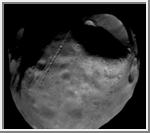 High Resolution Mosaic of Phobos
High Resolution Mosaic of Phobos
This high-resolution mosaic of Phobos was created from three
Viking orbiter images. The striking feature in this image is the
giant Stickney crater. Grooved fractures caused from the impact
that created Stickney extend away from the crater.
(Copyright © 1997 by Calvin J. Hamilton)
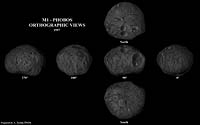 Six Views of Phobos
Six Views of Phobos
This picture shows six different orientations of Phobos. The images were
rendered by using Peter C. Thomas' model and the USGS airbrush
map of Phobos.
(Courtesy A. Tayfun Oner)
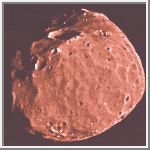 Phobos
Phobos
This image was taken by the
Viking Orbiter spacecraft in 1977.
Striated patterns can be seen in this image. These are
probably cracks caused by the impact event of the Stickney crater shown
below.
(Courtesy NASA)
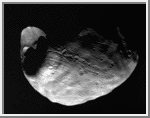 Stickney Crater
Stickney Crater
One of the most striking features of Phobos, aside from its irregular
shape, is its giant crater Stickney. Because Phobos is only 28 by 20 kilometers (17 by 12 miles), the moon must have been nearly shattered from the force of the impact that
caused the giant crater. Grooves that extend across the surface from
Stickney appear to be surface fractures caused by the impact. Near the
crater, the grooves measure about 700 meters (2300 feet) across and 90 meters (295 feet)
deep. However, most of the grooves have widths and depths in the 100 to
200 meters (328 to 655 feet) and 10 to 20 meters (33 to 65 feet) ranges, respectively.
(Courtesy NASA)
 Stickney Crater Another View
Stickney Crater Another View
This image shows a slightly different view of the Stickney crater.
A crater within the Stickney crater is visible.
(Courtesy Calvin J. Hamilton)
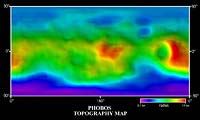 Topographic Map of Phobos
Topographic Map of Phobos
This is a topographic map of Phobos. It is based upon the shape model of Phil
Stooke. As with all maps, it is the cartographer's interpretation;
not all features are necessarily certain given the limited data
available. This interpretation stretches the data as far as possible.
(Courtesy A. Tayfun Oner)
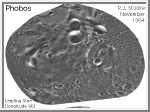 Conformal Projection of Phobos
Conformal Projection of Phobos
This shows two different views of Phobos in a Morphographic
Conformal Projection. One view shows the
leading side and the
other the trailing side.
(Courtesy Phil Stooke, NSSDC, and NASA)
Copyright © 1997-2000 by Calvin J. Hamilton. All rights reserved. Privacy Statement.